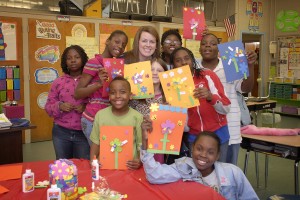
TUSCALOOSA, Ala. — University of Alabama student Katie McMurray has 20 young friends who eagerly await her company every Friday afternoon. These 11-year-olds are not her college friends, but McMurray hopes they will attend one day.
A UA senior from Charlotte, N.C., McMurray is mentoring the youngsters at Matthews Elementary School in Northport as part of a service learning class at UA directed by Dr. Kim Lackey, optical analysis coordinator/instructor in the department of biological sciences.
Even though McMurray has been mentoring the same group of students every Friday for the past three years, she says there is not a week that goes by when she can’t wait to visit her [now] 5th-grade friends.
“I love it when you walk into the classroom and all the kids will start yelling your name and then rush to you,” she said.
Recently, McMurray was accepted into medical school at the Debusk College of Osteopathic Medicine at Lincoln Memorial University in Harrogate, Tenn., where she plans to fulfill her lifelong dream of becoming a pediatrician and continuing her work with children.
McMurray began volunteering at Matthews Elementary two years before the formal mentoring program was established and as a result has been able to guide and assist the same students.
A majority of students who attend Matthews Elementary are considered “at risk” academically, economically and socially, Lackey explains. These students live in areas classified as “low income.” Almost 90 percent of the students at Matthews receive either free lunch or reduced lunch and have very little access to free Internet or social services as well as having no public library or public transportation in their area.
As a result, “the percentage of students not meeting academic standards in reading is significantly higher at Matthews than systemwide averages,” Lackey explains.
With the disadvantages these students face, having a quality after-school academic program can benefit the students academically and socially, but it also serves as a helping hand in uniting the community at large.
“These kids trust us, they feel comfortable coming to one of the mentors and talking about private issues that they didn’t feel comfortable talking about with their parents or teachers.” said McMurray. McMurray goes on to say that this kind of bond is important because it enables her to “lead by example and guide the kids in the right direction.”
When asked how mentoring the children has affected her outlook, McMurray said that it wasn’t until after she started working with the students that she truly realized how much they touched her. “One person really can make a difference in someone else’s life,” she has found.
McMurray hopes that by coming to the school each week and mentoring the at-risk students that she is guiding them in the right direction and reinforcing that they too can one day go to college. She says if the elementary students are exposed to the UA campus as well as interacting with college students, the idea of college becomes more real and attainable to them.
“If they can’t see it [going to college], it’s harder for them to believe it,” she says.
Focusing on her interest in heath care, McMurray also makes time to volunteer each week at Tuscaloosa’s Good Samaritan Clinic. In her work at the free clinic, McMurray does a number of jobs ranging from triage to the front desk to assisting the patient need office. McMurray has also been involved on campus as president of her sorority and in the Student Government Association.
The outreach program is funded through the Riverfront 21st Century Community Learning Center grant and partnered with the UA College of Arts and Sciences biology department, where what started as 15 upper level biology students has now grown to 32 students who will enroll in the outreach program and receive two hours of credit for the class.
Lackey requires the students to create a lesson plan where they choose an age appropriate topic, develop a related hands-on activity, provide a list of required materials and execute their idea. Many of the students enrolled in the class are on the pre-health professional track with a goal to become a physician, dentist or pharmacist.
Contact
Chloe LeBaron or Linda Hill, UA Media Relations, 205/348-8325 or lhill@ur.ua.edu
Source
Katie McMurray, 704/451-1096 or klmcmurray@bama.ua.edu